warning FIAT DOBLO COMBI 2010 Owner handbook (in English)
[x] Cancel search | Manufacturer: FIAT, Model Year: 2010, Model line: DOBLO COMBI, Model: FIAT DOBLO COMBI 2010Pages: 274, PDF Size: 6.16 MB
Page 112 of 274
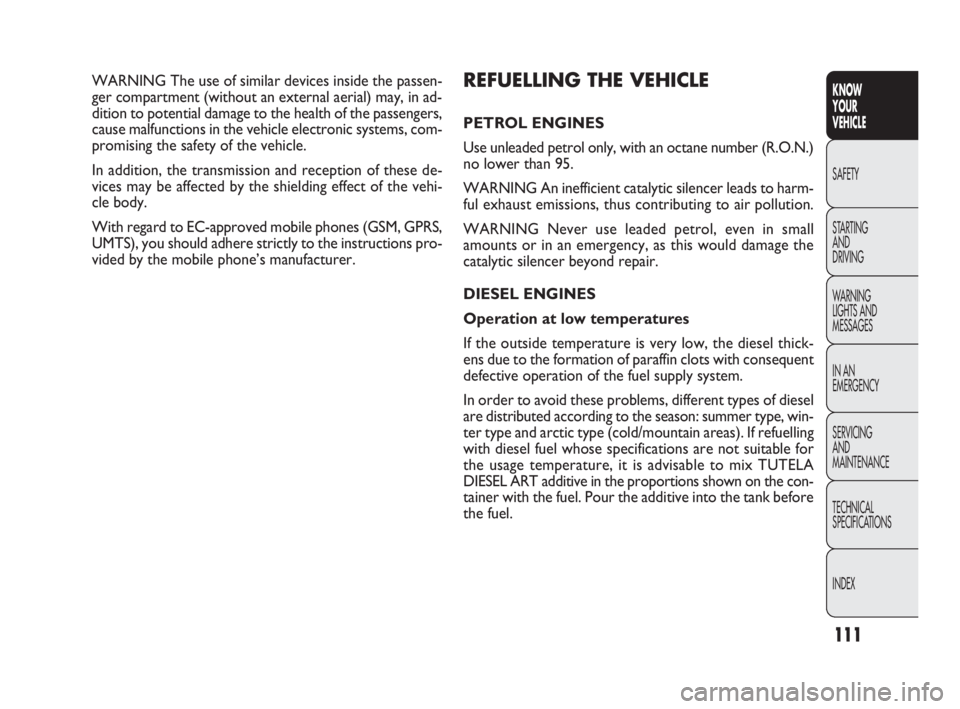
111
KNOW
YOUR
VEHICLE
SAFETY
STARTING
AND
DRIVING
WARNING
LIGHTS AND
MESSAGES
IN AN
EMERGENCY
SERVICING
AND
MAINTENANCE
TECHNICAL
SPECIFICATIONS
INDEX
REFUELLING THE VEHICLE
PETROL ENGINES
Use unleaded petrol only, with an octane number (R.O.N.)
no lower than 95.
WARNING An inefficient catalytic silencer leads to harm-
ful exhaust emissions, thus contributing to air pollution.
WARNING Never use leaded petrol, even in small
amounts or in an emergency, as this would damage the
catalytic silencer beyond repair.
DIESEL ENGINES
Operation at low temperatures
If the outside temperature is very low, the diesel thick-
ens due to the formation of paraffin clots with consequent
defective operation of the fuel supply system.
In order to avoid these problems, different types of diesel
are distributed according to the season: summer type, win-
ter type and arctic type (cold/mountain areas). If refuelling
with diesel fuel whose specifications are not suitable for
the usage temperature, it is advisable to mix TUTELA
DIESEL ART additive in the proportions shown on the con-
tainer with the fuel. Pour the additive into the tank before
the fuel. WARNING The use of similar devices inside the passen-
ger compartment (without an external aerial) may, in ad-
dition to potential damage to the health of the passengers,
cause malfunctions in the vehicle electronic systems, com-
promising the safety of the vehicle.
In addition, the transmission and reception of these de-
vices may be affected by the shielding effect of the vehi-
cle body.
With regard to EC-approved mobile phones (GSM, GPRS,
UMTS), you should adhere strictly to the instructions pro-
vided by the mobile phone’s manufacturer.
035-114 DOBLO LUM EN 2e 7.0 21-05-2010 9:55 Pagina 111
Page 113 of 274
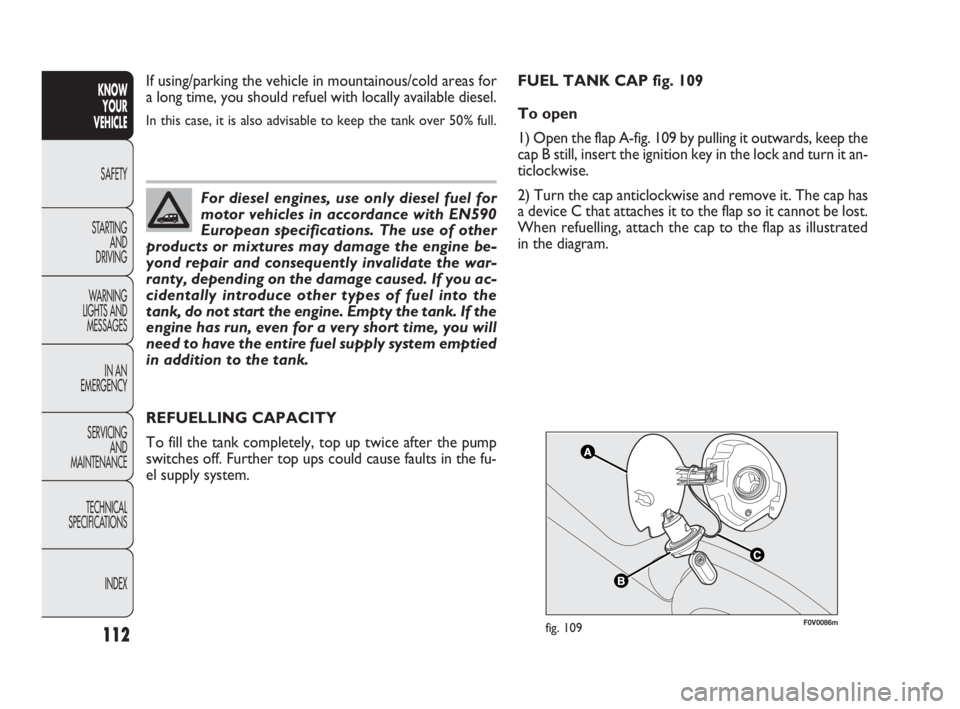
112
KNOW
YOUR
VEHICLE
SAFETY
STARTING
AND
DRIVING
WARNING
LIGHTS AND
MESSAGES
IN AN
EMERGENCY
SERVICING
AND
MAINTENANCE
TECHNICAL
SPECIFICATIONS
INDEX
F0V0086mfig. 109
REFUELLING CAPACITY
To fill the tank completely, top up twice after the pump
switches off. Further top ups could cause faults in the fu-
el supply system. If using/parking the vehicle in mountainous/cold areas for
a long time, you should refuel with locally available diesel.
In this case, it is also advisable to keep the tank over 50% full.
For diesel engines, use only diesel fuel for
motor vehicles in accordance with EN590
European specifications. The use of other
products or mixtures may damage the engine be-
yond repair and consequently invalidate the war-
ranty, depending on the damage caused. If you ac-
cidentally introduce other types of fuel into the
tank, do not start the engine. Empty the tank. If the
engine has run, even for a very short time, you will
need to have the entire fuel supply system emptied
in addition to the tank.
FUEL TANK CAP fig. 109
To open
1) Open the flap A-fig. 109 by pulling it outwards, keep the
cap B still, insert the ignition key in the lock and turn it an-
ticlockwise.
2) Turn the cap anticlockwise and remove it. The cap has
a device C that attaches it to the flap so it cannot be lost.
When refuelling, attach the cap to the flap as illustrated
in the diagram.
035-114 DOBLO LUM EN 2e 7.0 21-05-2010 9:55 Pagina 112
Page 114 of 274
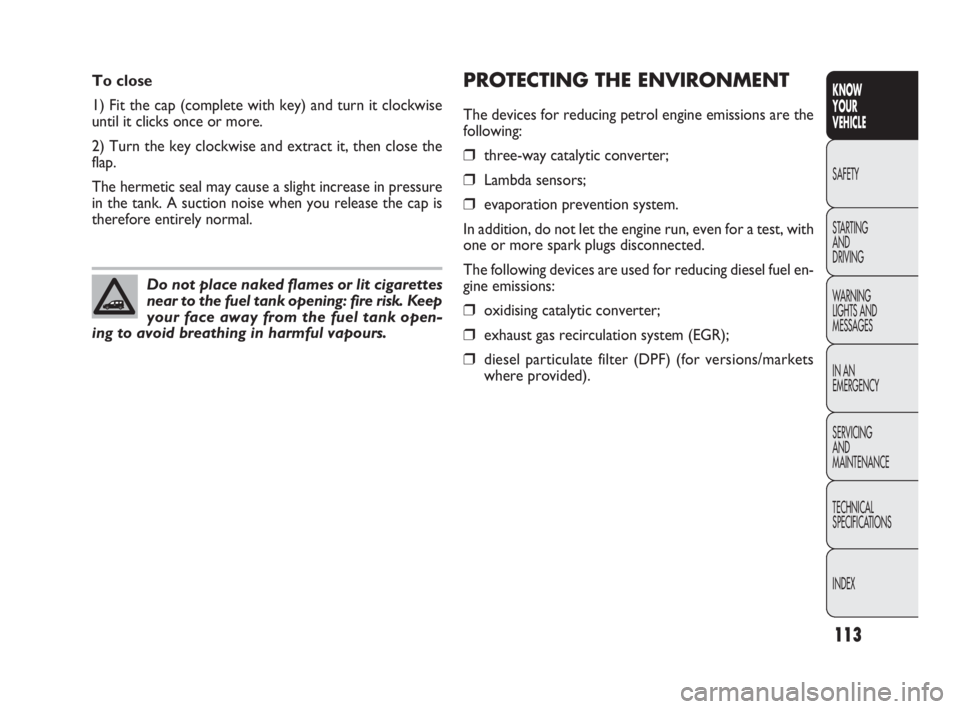
113
KNOW
YOUR
VEHICLE
SAFETY
STARTING
AND
DRIVING
WARNING
LIGHTS AND
MESSAGES
IN AN
EMERGENCY
SERVICING
AND
MAINTENANCE
TECHNICAL
SPECIFICATIONS
INDEX
PROTECTING THE ENVIRONMENT
The devices for reducing petrol engine emissions are the
following:
❒three-way catalytic converter;
❒Lambda sensors;
❒evaporation prevention system.
In addition, do not let the engine run, even for a test, with
one or more spark plugs disconnected.
The following devices are used for reducing diesel fuel en-
gine emissions:
❒oxidising catalytic converter;
❒exhaust gas recirculation system (EGR);
❒diesel particulate filter (DPF) (for versions/markets
where provided). To close
1) Fit the cap (complete with key) and turn it clockwise
until it clicks once or more.
2) Turn the key clockwise and extract it, then close the
flap.
The hermetic seal may cause a slight increase in pressure
in the tank. A suction noise when you release the cap is
therefore entirely normal.
Do not place naked flames or lit cigarettes
near to the fuel tank opening: fire risk. Keep
your face away from the fuel tank open-
ing to avoid breathing in harmful vapours.
035-114 DOBLO LUM EN 2e 7.0 21-05-2010 9:55 Pagina 113
Page 115 of 274
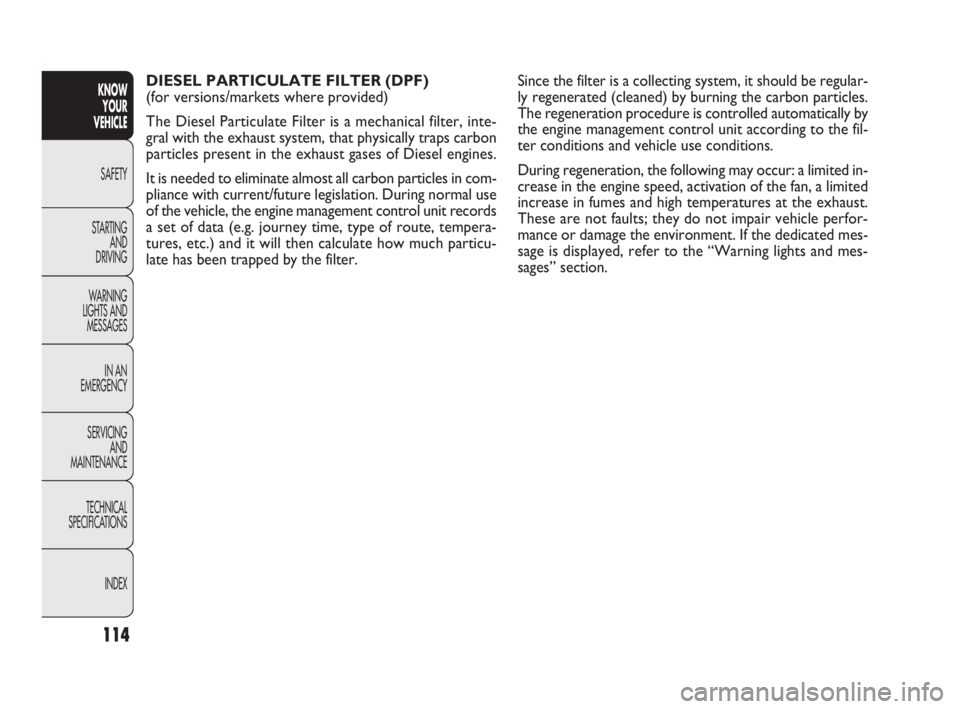
114
KNOW
YOUR
VEHICLE
SAFETY
STARTING
AND
DRIVING
WARNING
LIGHTS AND
MESSAGES
IN AN
EMERGENCY
SERVICING
AND
MAINTENANCE
TECHNICAL
SPECIFICATIONS
INDEX
DIESEL PARTICULATE FILTER (DPF)
(for versions/markets where provided)
The Diesel Particulate Filter is a mechanical filter, inte-
gral with the exhaust system, that physically traps carbon
particles present in the exhaust gases of Diesel engines.
It is needed to eliminate almost all carbon particles in com-
pliance with current/future legislation. During normal use
of the vehicle, the engine management control unit records
a set of data (e.g. journey time, type of route, tempera-
tures, etc.) and it will then calculate how much particu-
late has been trapped by the filter.Since the filter is a collecting system, it should be regular-
ly regenerated (cleaned) by burning the carbon particles.
The regeneration procedure is controlled automatically by
the engine management control unit according to the fil-
ter conditions and vehicle use conditions.
During regeneration, the following may occur: a limited in-
crease in the engine speed, activation of the fan, a limited
increase in fumes and high temperatures at the exhaust.
These are not faults; they do not impair vehicle perfor-
mance or damage the environment. If the dedicated mes-
sage is displayed, refer to the “Warning lights and mes-
sages” section.
035-114 DOBLO LUM EN 2e 7.0 21-05-2010 9:55 Pagina 114
Page 116 of 274
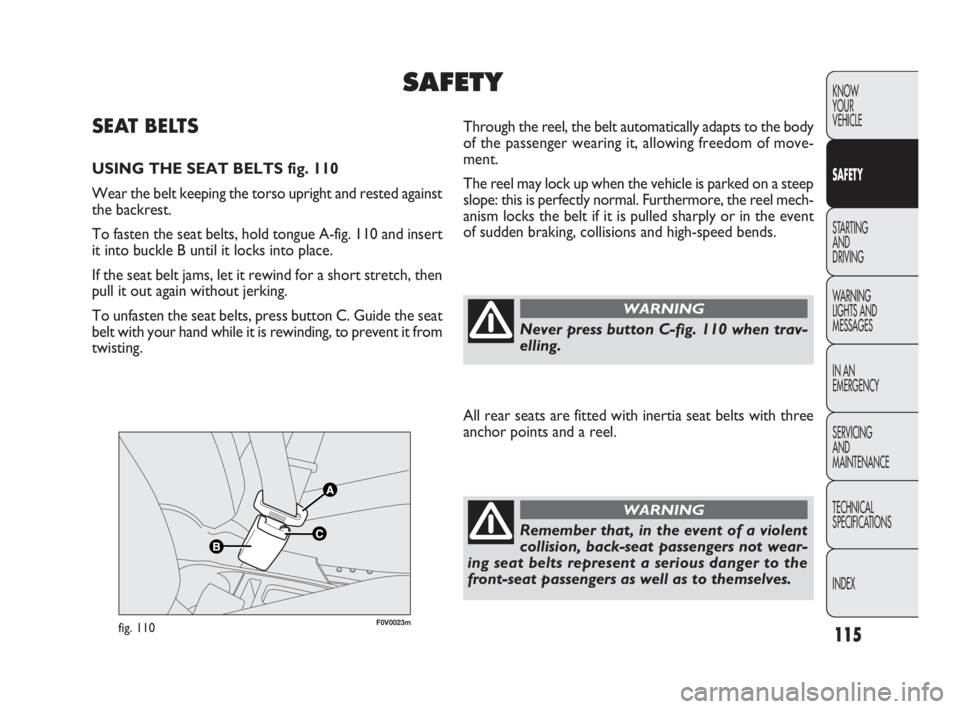
115
KNOW
YOUR
VEHICLE
SAFETY
STARTING
AND
DRIVING
WARNING
LIGHTS AND
MESSAGES
IN AN
EMERGENCY
SERVICING
AND
MAINTENANCE
TECHNICAL
SPECIFICATIONS
INDEX
F0V0023mfig. 110
Through the reel, the belt automatically adapts to the body
of the passenger wearing it, allowing freedom of move-
ment.
The reel may lock up when the vehicle is parked on a steep
slope: this is perfectly normal. Furthermore, the reel mech-
anism locks the belt if it is pulled sharply or in the event
of sudden braking, collisions and high-speed bends.SEAT BELTS
USING THE SEAT BELTS fig. 110
Wear the belt keeping the torso upright and rested against
the backrest.
To fasten the seat belts, hold tongue A-fig. 110 and insert
it into buckle B until it locks into place.
If the seat belt jams, let it rewind for a short stretch, then
pull it out again without jerking.
To unfasten the seat belts, press button C. Guide the seat
belt with your hand while it is rewinding, to prevent it from
twisting.
SAFETY
Never press button C-fig. 110 when trav-
elling.
WARNING
All rear seats are fitted with inertia seat belts with three
anchor points and a reel.
Remember that, in the event of a violent
collision, back-seat passengers not wear-
ing seat belts represent a serious danger to the
front-seat passengers as well as to themselves.
WARNING
115-132 DOBLO LUM EN 2e 7.0 21-05-2010 11:11 Pagina 115
Page 117 of 274
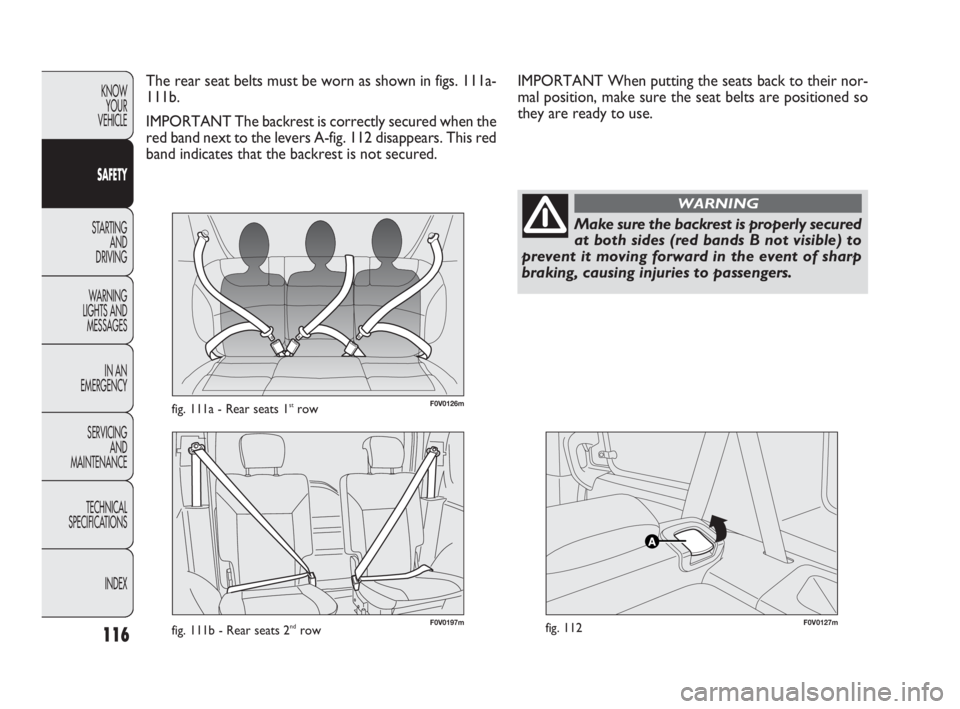
116
KNOW
YOUR
VEHICLE
SAFETY
STARTING
AND
DRIVING
WARNING
LIGHTS AND
MESSAGES
IN AN
EMERGENCY
SERVICING
AND
MAINTENANCE
TECHNICAL
SPECIFICATIONS
INDEX
F0V0126mfig. 111a - Rear seats 1strow
F0V0127mfig. 112
The rear seat belts must be worn as shown in figs. 111a-
111b.
IMPORTANT The backrest is correctly secured when the
red band next to the levers A-fig. 112 disappears. This red
band indicates that the backrest is not secured.
Make sure the backrest is properly secured
at both sides (red bands B not visible) to
prevent it moving forward in the event of sharp
braking, causing injuries to passengers.
WARNING
IMPORTANT When putting the seats back to their nor-
mal position, make sure the seat belts are positioned so
they are ready to use.
F0V0197mfig. 111b - Rear seats 2ndrow
115-132 DOBLO LUM EN 2e 7.0 21-05-2010 11:11 Pagina 116
Page 118 of 274
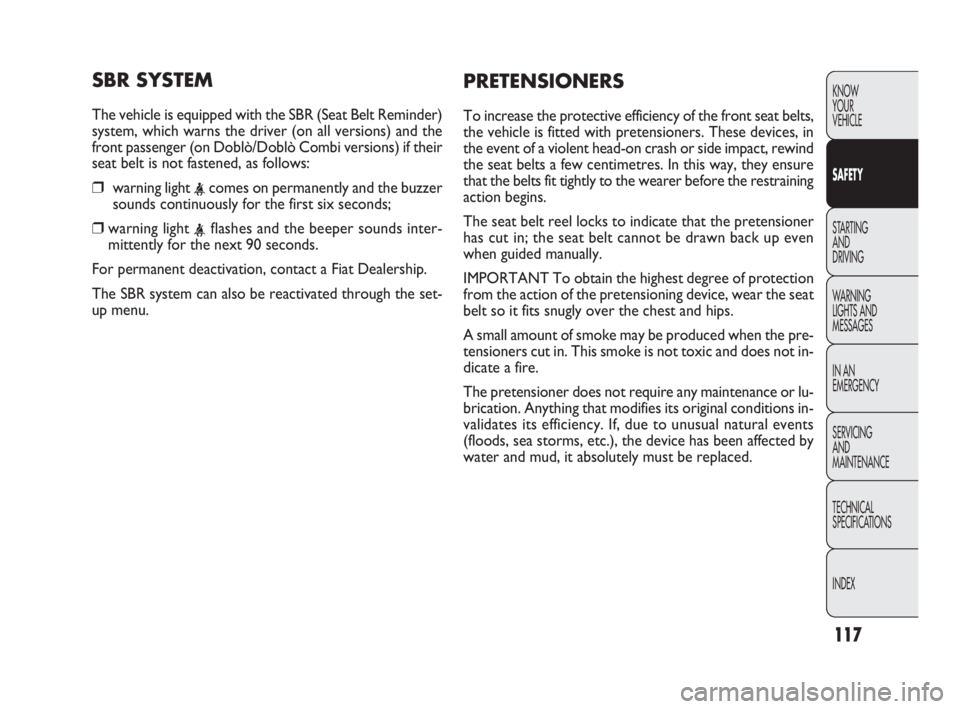
117
KNOW
YOUR
VEHICLE
SAFETY
STARTING
AND
DRIVING
WARNING
LIGHTS AND
MESSAGES
IN AN
EMERGENCY
SERVICING
AND
MAINTENANCE
TECHNICAL
SPECIFICATIONS
INDEX
SBR SYSTEM
The vehicle is equipped with the SBR (Seat Belt Reminder)
system, which warns the driver (on all versions) and the
front passenger (on Doblò/Doblò Combi versions) if their
seat belt is not fastened, as follows:
❒warning light
❒warning light
For permanent deactivation, contact a Fiat Dealership.
The SBR system can also be reactivated through the set-
up menu.
PRETENSIONERS
To increase the protective efficiency of the front seat belts,
the vehicle is fitted with pretensioners. These devices, in
the event of a violent head-on crash or side impact, rewind
the seat belts a few centimetres. In this way, they ensure
that the belts fit tightly to the wearer before the restraining
action begins.
The seat belt reel locks to indicate that the pretensioner
has cut in; the seat belt cannot be drawn back up even
when guided manually.
IMPORTANT To obtain the highest degree of protection
from the action of the pretensioning device, wear the seat
belt so it fits snugly over the chest and hips.
A small amount of smoke may be produced when the pre-
tensioners cut in. This smoke is not toxic and does not in-
dicate a fire.
The pretensioner does not require any maintenance or lu-
brication. Anything that modifies its original conditions in-
validates its efficiency. If, due to unusual natural events
(floods, sea storms, etc.), the device has been affected by
water and mud, it absolutely must be replaced.
115-132 DOBLO LUM EN 2e 7.0 21-05-2010 11:11 Pagina 117
Page 119 of 274
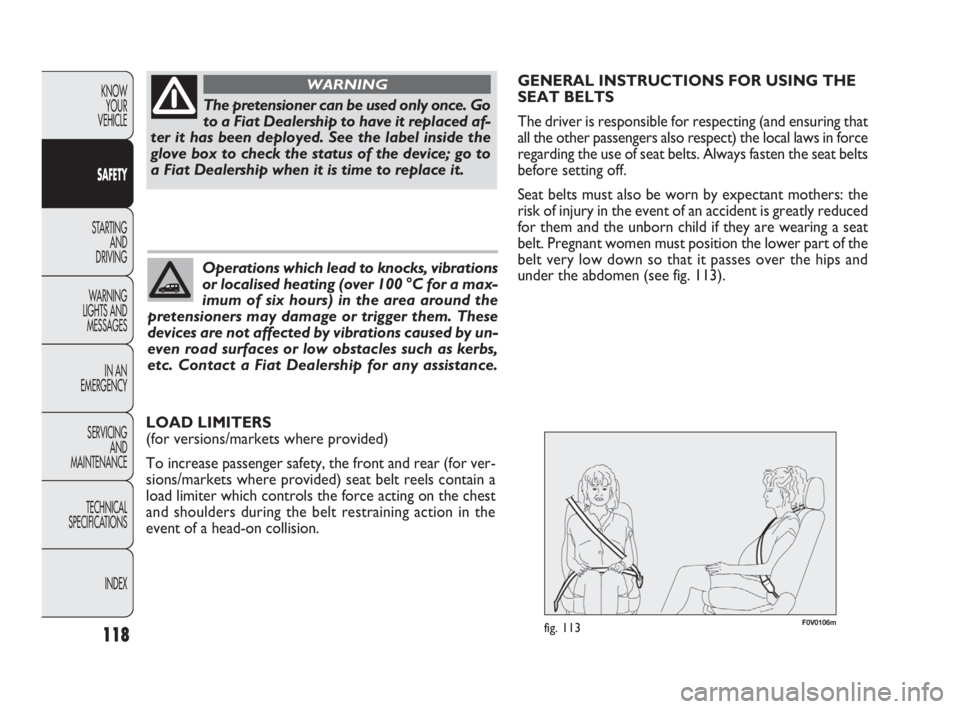
F0V0106mfig. 113118
KNOW
YOUR
VEHICLE
SAFETY
STARTING
AND
DRIVING
WARNING
LIGHTS AND
MESSAGES
IN AN
EMERGENCY
SERVICING
AND
MAINTENANCE
TECHNICAL
SPECIFICATIONS
INDEX
The pretensioner can be used only once. Go
to a Fiat Dealership to have it replaced af-
ter it has been deployed. See the label inside the
glove box to check the status of the device; go to
a Fiat Dealership when it is time to replace it.
WARNING
Operations which lead to knocks, vibrations
or localised heating (over 100 °C for a max-
imum of six hours) in the area around the
pretensioners may damage or trigger them. These
devices are not affected by vibrations caused by un-
even road surfaces or low obstacles such as kerbs,
etc. Contact a Fiat Dealership for any assistance.
GENERAL INSTRUCTIONS FOR USING THE
SEAT BELTS
The driver is responsible for respecting (and ensuring that
all the other passengers also respect) the local laws in force
regarding the use of seat belts. Always fasten the seat belts
before setting off.
Seat belts must also be worn by expectant mothers: the
risk of injury in the event of an accident is greatly reduced
for them and the unborn child if they are wearing a seat
belt. Pregnant women must position the lower part of the
belt very low down so that it passes over the hips and
under the abdomen (see fig. 113).
LOAD LIMITERS
(for versions/markets where provided)
To increase passenger safety, the front and rear (for ver-
sions/markets where provided) seat belt reels contain a
load limiter which controls the force acting on the chest
and shoulders during the belt restraining action in the
event of a head-on collision.
115-132 DOBLO LUM EN 2e 7.0 21-05-2010 11:11 Pagina 118
Page 120 of 274
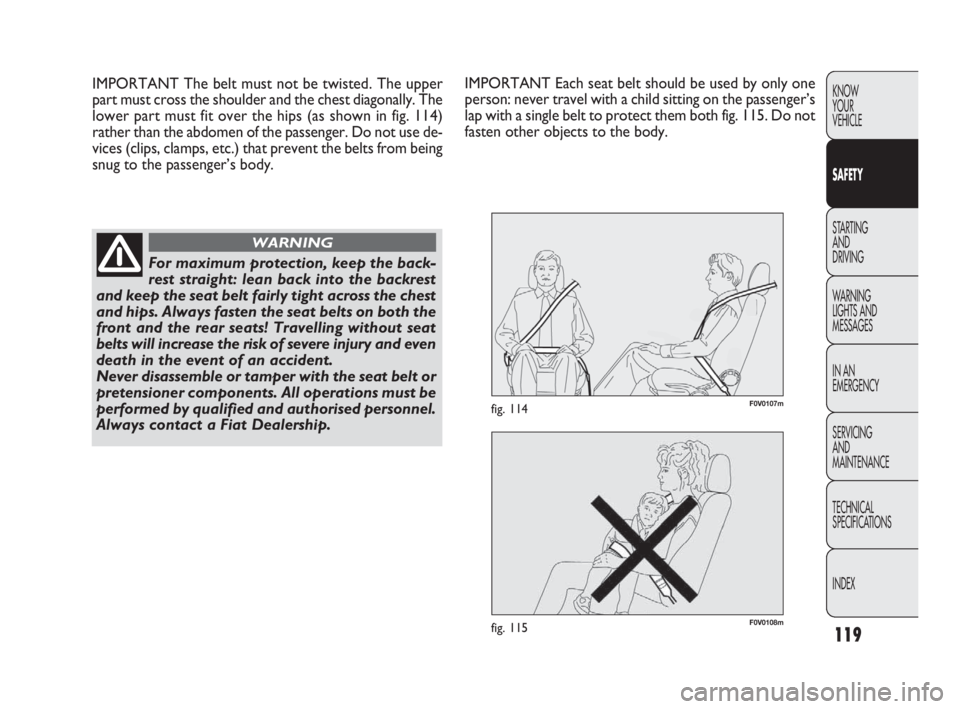
119
KNOW
YOUR
VEHICLE
SAFETY
STARTING
AND
DRIVING
WARNING
LIGHTS AND
MESSAGES
IN AN
EMERGENCY
SERVICING
AND
MAINTENANCE
TECHNICAL
SPECIFICATIONS
INDEX
F0V0108mfig. 115
F0V0107mfig. 114
IMPORTANT The belt must not be twisted. The upper
part must cross the shoulder and the chest diagonally. The
lower part must fit over the hips (as shown in fig. 114)
rather than the abdomen of the passenger. Do not use de-
vices (clips, clamps, etc.) that prevent the belts from being
snug to the passenger’s body.
For maximum protection, keep the back-
rest straight: lean back into the backrest
and keep the seat belt fairly tight across the chest
and hips. Always fasten the seat belts on both the
front and the rear seats! Travelling without seat
belts will increase the risk of severe injury and even
death in the event of an accident.
Never disassemble or tamper with the seat belt or
pretensioner components. All operations must be
performed by qualified and authorised personnel.
Always contact a Fiat Dealership.
WARNING
IMPORTANT Each seat belt should be used by only one
person: never travel with a child sitting on the passenger’s
lap with a single belt to protect them both fig. 115. Do not
fasten other objects to the body.
115-132 DOBLO LUM EN 2e 7.0 21-05-2010 11:11 Pagina 119
Page 121 of 274
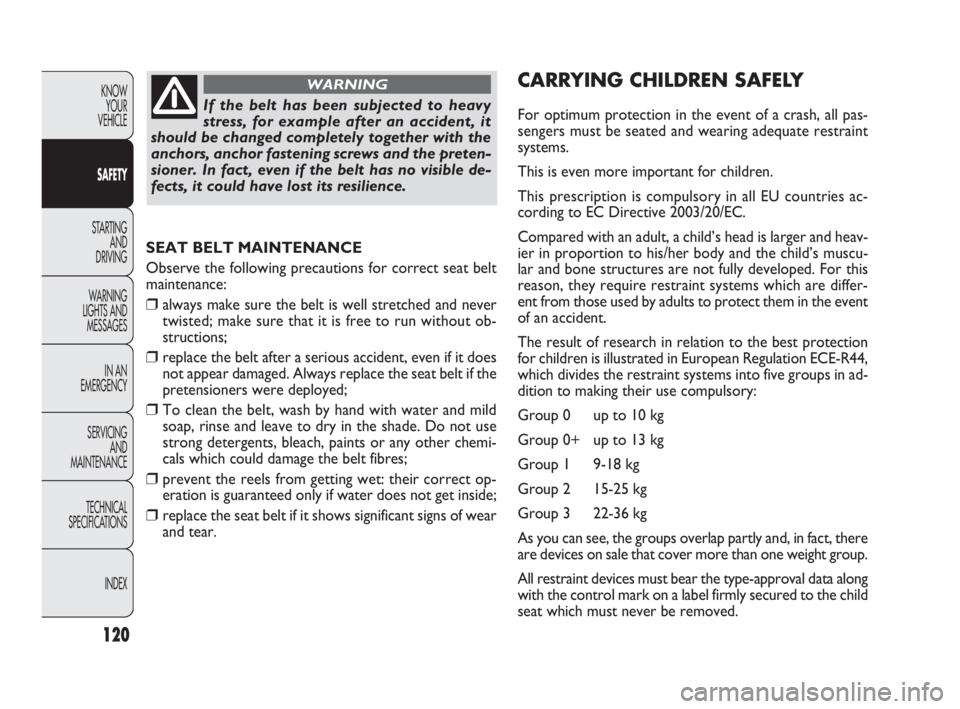
120
KNOW
YOUR
VEHICLE
SAFETY
STARTING
AND
DRIVING
WARNING
LIGHTS AND
MESSAGES
IN AN
EMERGENCY
SERVICING
AND
MAINTENANCE
TECHNICAL
SPECIFICATIONS
INDEX
SEAT BELT MAINTENANCE
Observe the following precautions for correct seat belt
maintenance:
❒always make sure the belt is well stretched and never
twisted; make sure that it is free to run without ob-
structions;
❒replace the belt after a serious accident, even if it does
not appear damaged. Always replace the seat belt if the
pretensioners were deployed;
❒To clean the belt, wash by hand with water and mild
soap, rinse and leave to dry in the shade. Do not use
strong detergents, bleach, paints or any other chemi-
cals which could damage the belt fibres;
❒prevent the reels from getting wet: their correct op-
eration is guaranteed only if water does not get inside;
❒replace the seat belt if it shows significant signs of wear
and tear.
If the belt has been subjected to heavy
stress, for example after an accident, it
should be changed completely together with the
anchors, anchor fastening screws and the preten-
sioner. In fact, even if the belt has no visible de-
fects, it could have lost its resilience.
WARNINGCARRYING CHILDREN SAFELY
For optimum protection in the event of a crash, all pas-
sengers must be seated and wearing adequate restraint
systems.
This is even more important for children.
This prescription is compulsory in all EU countries ac-
cording to EC Directive 2003/20/EC.
Compared with an adult, a child’s head is larger and heav-
ier in proportion to his/her body and the child’s muscu-
lar and bone structures are not fully developed. For this
reason, they require restraint systems which are differ-
ent from those used by adults to protect them in the event
of an accident.
The result of research in relation to the best protection
for children is illustrated in European Regulation ECE-R44,
which divides the restraint systems into five groups in ad-
dition to making their use compulsory:
Group 0 up to 10 kg
Group 0+ up to 13 kg
Group 1 9-18 kg
Group 2 15-25 kg
Group 3 22-36 kg
As you can see, the groups overlap partly and, in fact, there
are devices on sale that cover more than one weight group.
All restraint devices must bear the type-approval data along
with the control mark on a label firmly secured to the child
seat which must never be removed.
115-132 DOBLO LUM EN 2e 7.0 21-05-2010 11:11 Pagina 120